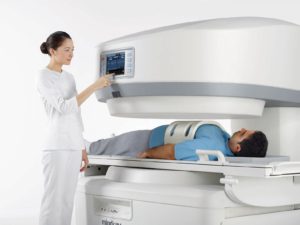 What is Spinal Decompression Surgery?
What is Spinal Decompression Surgery?
Spinal decompression surgery has the goal of decompressing pinched spinal cord nerves and relieving intense back or neck pain. It involves removing a piece of spinal disc, lamina, or expanding areas of the spine like the foramen. This process can reduce or eliminate the nerve pinching which is responsible for nerve pain. The operation has to be precise and identify the exact location of the problem so it can be successfully corrected during the procedure. Some patients have more than one area that needs to be worked on.
The exact procedure and how long it takes depends on several factors. When any part of the lamina bone in the spine is removed it is referred to as a Laminectomy. The procedure may be necessary due to a spine trauma, a genetic development, spinal stenosis, or a herniated disc. Before the procedure is scheduled your doctor will perform a variety of tests.
Open MRI for Spinal Decompression
Testing such as an open MRI and X-Ray allow your spine doctor to see the specific elements of the spine. This includes the discs, if there are any out of alignment or any bulging, and the nerve endings. A treatment plan, usually including physical therapy, is created to help offer pain relief. Surgery is only considered when non-surgical treatment options aren’t helping or they aren’t enough to take care of the situation.
 The specifics including where the incision will be and the best method to help reduce the pressure on the spine and the nerve roots. The goal is to get the best result possible for each patient. The area of the pain, the severity of the compression, and other factors all have to be evaluated. This ensures the professionals can develop the best strategy for the surgery and reduce the risk of problems.
The specifics including where the incision will be and the best method to help reduce the pressure on the spine and the nerve roots. The goal is to get the best result possible for each patient. The area of the pain, the severity of the compression, and other factors all have to be evaluated. This ensures the professionals can develop the best strategy for the surgery and reduce the risk of problems.
Types of Spinal Decompression Surgery
Spinal nerves can be pinched a few different ways. Herniated discs are one of the most common causes of back pain, which happens when a spinal disc is either weak and bulges over time, or due to a sudden spinal impact like during a car accident. The bulge presses on nearby spinal nerves causing intense back or neck pain. The surgery for herniated discs is called a discectomy, which decompresses the spinal area being compressed by the disc.
The Laminectomy was mentioned previously, and removes all of or part of the lamina, which is part of the spinal vertebra bone. The lamina can also compress the spinal nerves and cause pain, and when removed it also decompresses the spinal nerves. Usually this is performed due to a herniated disc, or spinal stenosis, which is a narrowing of the spinal canal.
Laser spine surgery also helps decompress the spine by inserting a needle directly into the herniating disc and decompressing it with heat from a laser. The laser is fed through the needle and evaporates a portion of the disc, which then reduces the bulge and causes the spinal nerves to be decompressed. This surgery is very minimally invasive since cutting isn’t required, only a small needle insertion.
Benefits of Spinal Decompression
Approximately 70% feel pain relief from spinal decompression surgery, and this is encouraging. Many patients find they feel better when they wake up from the procedure and go through the early stages of recovery. Such improvements can include less pain, additional mobility, and feeling back in the legs or buttocks if they were numb before.
 Spinal Decompression Risks
Spinal Decompression Risks
There is always the risk of infection with any type of surgery, but can be mitigated with proper sterilization and best operating room practices. There is also a risk that there will be no or little pain relief after surgery, or nerve and blood vessel damage. Be sure to tell your doctor of any concerns before the surgery, and discuss any medical history that may effect the surgery such as allergies, medications, or other pre-existing conditions. The decision to undergo such a procedure isn’t always easy. Most patients decide to move forward with it because the possible benefits for them outweigh the potential risks.
Failure to follow instructions after recovery can lead to risks. Patients need to keep all follow-up appointments. They need to limit movements, go to their physical therapy appointments, and pay attention to any signs of infection. Following the recovery instructions correctly can reduce potential risks. Make sure you ask any questions you may have and report anything that doesn’t seem right. This includes any numbness or additional pain after the procedure.
 Spinal Decompression Recovery Period
Spinal Decompression Recovery Period
An overnight stay is common with spinal surgery. It allows professionals to monitor your progress. Most patients can get up and walk around just a few hours after the procedure is completed. The back may be sore for several days after the procedure. Medications may be given to help control the pain.
The recovery period after spinal decompression ranges from 4 to 6 weeks. It depends on the amount of work done during the procedure and the overall health of the patient. It is important to have someone to take you home after the procedure. Follow all directions to help the incision heal and reduce infection. Avoid lifting or repetitive movements until your doctor releases you to engage in them again.
You may need to take several weeks off work or work with restrictions while you heal. Physical therapy is often part of the healing process. This helps speed along the healing and helps the body get stronger. Keep all scheduled appointments and complete exercises you are given to complete at home.
Does Spinal Decompression Work?
As you explore the possibility of spinal decompression, you will read various responses to it. Some patients feel it is the only option that really helped them. They are thankful they can get back to their normal life without back pain. However, depending on the surgery, the rate of long lasting pain relief is between 50% and 70%, so more treatments may be required after the surgery.
 There are plenty of patients who feel spinal decompression helped them control pain and have additional mobility. It improved their quality of life due to the benefits gained. Evaluating what is available and your own situation can help you decide if this is a procedure you wish to pursue or not. You can also discuss all possible options with your doctor before considering surgery, since many patients feel pain management works while pursuing physical therapy with other lifestyle changes.
There are plenty of patients who feel spinal decompression helped them control pain and have additional mobility. It improved their quality of life due to the benefits gained. Evaluating what is available and your own situation can help you decide if this is a procedure you wish to pursue or not. You can also discuss all possible options with your doctor before considering surgery, since many patients feel pain management works while pursuing physical therapy with other lifestyle changes.
It is best to avoid movements or activities that could cause problems after back decompression surgery. You may need to alter your workplace routine so the issue doesn’t develop again in other areas of the spine. If the underlying problem was due to trauma, there is a good chance of a full recovery and resuming normal everyday activities.
Skilled Spinal Decompression Doctors
If your spine specialist feels you are a good candidate for spinal decompression operations, make sure they share the pros and cons of it with you. The results can vary for each patient and they should give you a clear picture of what you can expect with it in your case. AllSpine has highly skilled and experienced neurosurgeons fully capable of performing the full spinal decompression suite of surgeries. With thousands of surgeries performed we’ve helped our patients get back to that pain free life. Call 770-997-0600 to talk to a medical professional today.


